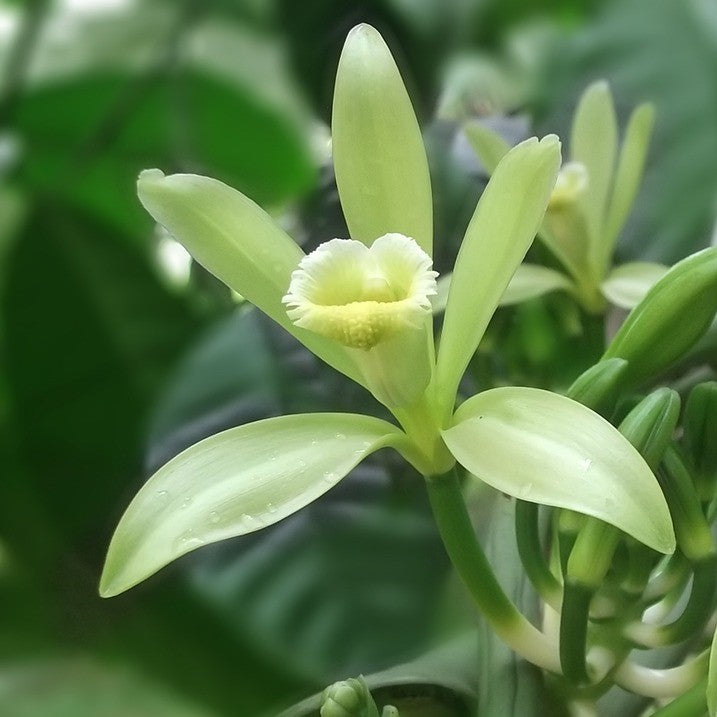
Why Does Vanilla Take So Long to Grow? The Lifecycle of a Vanilla Orchid
Share
Introduction
Ever wondered why real vanilla is so expensive and rare? The journey from vine to bean takes years, making vanilla one of the most labor-intensive crops in the world. Unlike other crops that can be harvested within months, vanilla orchids require years of careful cultivation, meticulous hand-pollination, and time-intensive curing before they reach your kitchen.
In this article, we’ll explore the hidden reasons why vanilla takes so long to grow, the intricate production process, and why it truly is a labor of love for farmers.
1. The Unique Nature of the Vanilla Orchid
Vanilla isn’t just any plant—it comes from the Vanilla planifolia orchid, one of the few orchids that produce edible fruit. This uniqueness plays a significant role in its slow growth cycle.
Why Vanilla is Different from Other Crops
- Unlike wheat or corn, vanilla cannot be planted and harvested within the same year.
- It requires a specific climate, typically found in tropical regions like Madagascar, Mexico, and Tahiti.
- It is highly sensitive to temperature, humidity, and soil conditions.
How Long Does it Take for a Vanilla Orchid to Mature?
- A vanilla vine takes 3–4 years just to produce its first flowers.
- The plant must climb and mature before it reaches the flowering stage.
- Farmers must monitor the vines carefully to ensure proper growth and support.
2. The Challenging Pollination Process
One of the most surprising facts about vanilla is that it does not naturally pollinate in most regions where it is grown today.
Why Can’t Vanilla Self-Pollinate?
- In its native habitat, vanilla orchids rely on a specific species of Melipona bees found in Mexico.
- In Madagascar, Tahiti, and other vanilla-producing regions, these bees do not exist.
- A natural barrier inside the flower prevents self-pollination.
The Manual Pollination Process
Since natural pollination rarely occurs outside Mexico, farmers must hand-pollinate every flower individually. Here’s how:
- Each morning, trained farmers carefully open each flower by hand.
- They use a small stick or a toothpick to transfer pollen from the male to the female part of the flower.
- If successful, the flower will develop into a vanilla bean within a few days.
- If not pollinated within 12 hours of blooming, the flower wilts and dies.
The labor-intensive nature of this process is one of the main reasons vanilla farming is so expensive and time-consuming.
3. The Long Wait: Growing and Harvesting Vanilla Beans
Once pollinated, vanilla beans don’t grow overnight. They require months of careful monitoring before they are ready for harvest.
How Long Does It Take for Vanilla Beans to Mature?
- After pollination, vanilla beans take 8–9 months to fully develop.
- During this time, the beans must stay on the vine to develop their complex flavors.
- Harvesting too early results in poor-quality, flavorless beans.
The Strict Selection Process
- Only fully mature beans are selected for harvest.
- Farmers must inspect each bean by hand, ensuring it is firm, fully developed, and has reached the right length.
4. Post-Harvest: Curing and Aging for Maximum Flavor
Even after the long wait, fresh vanilla beans have no aroma or flavor when first harvested. To develop their signature fragrance, they must go through a rigorous curing process.
The Four-Step Vanilla Curing Process
- Blanching: Fresh beans are quickly dipped in hot water to stop the ripening process.
- Sweating: Beans are wrapped in wool blankets and stored in wooden boxes for several days. This helps develop the dark color and rich aroma.
- Drying: Beans are laid out in the sun during the day and kept indoors at night. This process takes several weeks.
- Aging: Finally, beans are stored for several months to years to enhance their flavor profile.
Why Does Aging Matter?
- The longer vanilla beans age, the richer their vanillin content, the compound responsible for vanilla’s distinct aroma.
- High-quality vanilla beans are aged for up to 2 years.
5. Hidden Factors That Make Vanilla Growth So Slow
Aside from its natural growth cycle, external factors contribute to the time-intensive nature of vanilla farming.
Climate Change & Weather Challenges
- Vanilla requires stable temperatures and consistent rainfall.
- Extreme weather events, droughts, and storms can delay growth and reduce yields.
Pests & Diseases in Vanilla Farming
- Vanilla vines are susceptible to fungal infections and root rot.
- Pests like borers and beetles can damage the plants, further slowing growth.
Labor & Sustainability Issues
- The vanilla industry relies on skilled manual labor, but a shortage of experienced farmers can impact production.
- Unsustainable farming practices have led to deforestation and soil depletion, which affects future vanilla yields.
6. Why the Long Process is Worth It: The Value of Real Vanilla
Despite the long wait, real vanilla remains one of the most highly prized flavors in the world. Here’s why:
Real Vanilla vs. Artificial Vanilla
- Real vanilla contains over 200 natural flavor compounds, making it superior in taste and aroma.
- Artificial vanilla (vanillin) is made from synthetic chemicals and lacks depth.
Why Vanilla Prices Are So High
- Vanilla is the second most expensive spice in the world (after saffron) due to its labor-intensive production.
- Demand far exceeds supply, leading to high market prices.
How to Identify High-Quality Vanilla
- Look for moist, plump beans with a deep, rich aroma.
- Avoid dried-out, brittle beans, which indicate poor curing.
- Choose vanilla from reputable, sustainable sources.
Conclusion
Vanilla’s journey from orchid to bean to bottle is one of patience, dedication, and skill. The process—from 3–4 years of vine growth to 9 months of bean development and months of curing—explains why vanilla is so rare and valuable.
Next time you use real vanilla in your baking or cooking, remember: you’re not just enjoying a flavor—you’re experiencing years of craftsmanship and tradition.
Support Ethical Vanilla Farming
- Buy ethically sourced, fair-trade vanilla.
- Choose real vanilla over synthetic alternatives.
- Appreciate the hard work that farmers put into every single bean.
Vanilla is more than just an ingredient—it’s a labor of love.
